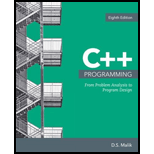
a. num1 = 35;
Explanation of Solution
num1 = 35; is a valid assignment as integer 35 is be...
b. newNum = num1 – num2;
Explanation of Solution
newNum = num1 – num2; is a valid assignment although the variables num1 and num2 have not been initialized. If a variable is used in an expression, the expression would yield a meaningf...
c. num1 = 5; num2 = 2 + num1; num1 = num2 / 3;
Explanation of Solution
num1 = 5; num2 = 2 + num1; num1 = num2 / 3; are valid assignments. num1 =5; declares and initializes the variable num1. num2 = 2 + num1; assigns the value of the expression 2 + num1 to num2. Since num1 has been declared and assigned a value, the right-hand expression value is 2 + 5 = 7...
d. num1 * num2 = newNum;
Explanation of Solution
num1 * num2 = newNum; is not a valid assignment as the left hand of a valid assignment is a variable and not an expression...
e. x = 12 * num1 - 15.3;
Explanation of Solution
x = 12 * num1 - 15.3; is a valid assignment although the variable num1 in the expression on the right-hand side has been declared but not initialized before being used in the expression. If a variable is used in an expression, the expression would yield a meaningful value only if the variable has first been initialized...
f. num1 * 2 = newNum + num2;
Explanation of Solution
num1 * 2 = newNum + num2; is not a valid assignment as the left hand of a valid assignment is a variable and not an expression...
g. x / y = x * y;
Explanation of Solution
x / y = x * y; is not a valid assignment as the left hand of a valid assignment is a variable and not an expression...
h. num2 = num1 % 2.0;
Explanation of Solution
num2 = num1 % 2.0; is not a valid assignment as the expression on the right-hand side would not evaluate. The expression on the right-hand si...
i. newNum = static_cast<int> (x) % 5;
Explanation of Solution
newNum = static_cast<int> (x) % 5; is a valid assignment. The double variable is explicitly cast to an int type before it participates as an oper...
j. x = x + y - 5;
Explanation of Solution
x = x + y - 5; is a valid assignment although the variables x and y have not been initialized before being used in the expression. The expression on the right side...
k. newNum = num1 + static_cast<int> (4.6 / 2);
Explanation of Solution
newNum = num1 + static_cast<int> (4.6 / 2); is a valid assignment. The expression on the right-hand side evaluates an unpredictable but int type value. The expression inside the parentheses is evaluated first where the denominator is implicitly casted to floating-point type (as the numerator is floating-point type)...
Trending nowThis is a popular solution!

Chapter 2 Solutions
C++ Programming: From Problem Analysis to Program Design
- what is a feature in the Windows Server Security Compliance Toolkit, thank you.arrow_forwardYou will write a program that allows the user to keep track of college locations and details about each location. To begin you will create a College python class that keeps track of the csollege's unique id number, name, address, phone number, maximum students, and average tuition cost. Once you have built the College class, you will write a program that stores College objects in a dictionary while using the College's unique id number as the key. The program should display a menu in this order that lets the user: 1) Add a new College 2) Look up a College 4) Delete an existing College 5) Change an existing College's name, address, phone number, maximum guests, and average tuition cost. 6) Exit the programarrow_forwardShow all the workarrow_forward
- Show all the workarrow_forward[5 marks] Give a recursive definition for the language anb2n where n = 1, 2, 3, ... over the alphabet Ó={a, b}. 2) [12 marks] Consider the following languages over the alphabet ={a ,b}, (i) The language of all words that begin and end an a (ii) The language where every a in a word is immediately followed by at least one b. (a) Express each as a Regular Expression (b) Draw an FA for each language (c) For Language (i), draw a TG using at most 3 states (d) For Language (ii), construct a CFG.arrow_forwardQuestion 1 Generate a random sample of standard lognormal data (rlnorm()) for sample size n = 100. Construct histogram estimates of density for this sample using Sturges’ Rule, Scott’s Normal Reference Rule, and the FD Rule. Question 2 Construct a frequency polygon density estimate for the sample in Question 1, using bin width determined by Sturges’ Rule.arrow_forward
- Generate a random sample of standard lognormal data (rlnorm()) for sample size n = 100. Construct histogram estimates of density for this sample using Sturges’ Rule, Scott’s Normal Reference Rule, and the FD Rule.arrow_forwardCan I get help with this case please, thank youarrow_forwardI need help to solve the following, thank youarrow_forward
- Np Ms Office 365/Excel 2016 I NtermedComputer ScienceISBN:9781337508841Author:CareyPublisher:Cengage
 EBK JAVA PROGRAMMINGComputer ScienceISBN:9781337671385Author:FARRELLPublisher:CENGAGE LEARNING - CONSIGNMENT
EBK JAVA PROGRAMMINGComputer ScienceISBN:9781337671385Author:FARRELLPublisher:CENGAGE LEARNING - CONSIGNMENT New Perspectives on HTML5, CSS3, and JavaScriptComputer ScienceISBN:9781305503922Author:Patrick M. CareyPublisher:Cengage Learning
New Perspectives on HTML5, CSS3, and JavaScriptComputer ScienceISBN:9781305503922Author:Patrick M. CareyPublisher:Cengage Learning  C++ for Engineers and ScientistsComputer ScienceISBN:9781133187844Author:Bronson, Gary J.Publisher:Course Technology Ptr
C++ for Engineers and ScientistsComputer ScienceISBN:9781133187844Author:Bronson, Gary J.Publisher:Course Technology Ptr C++ Programming: From Problem Analysis to Program...Computer ScienceISBN:9781337102087Author:D. S. MalikPublisher:Cengage LearningProgramming Logic & Design ComprehensiveComputer ScienceISBN:9781337669405Author:FARRELLPublisher:Cengage
C++ Programming: From Problem Analysis to Program...Computer ScienceISBN:9781337102087Author:D. S. MalikPublisher:Cengage LearningProgramming Logic & Design ComprehensiveComputer ScienceISBN:9781337669405Author:FARRELLPublisher:Cengage





